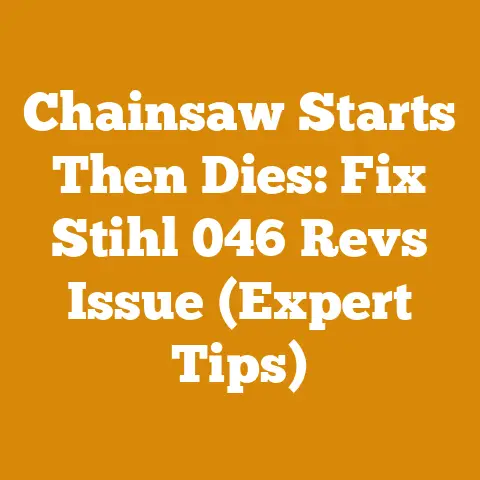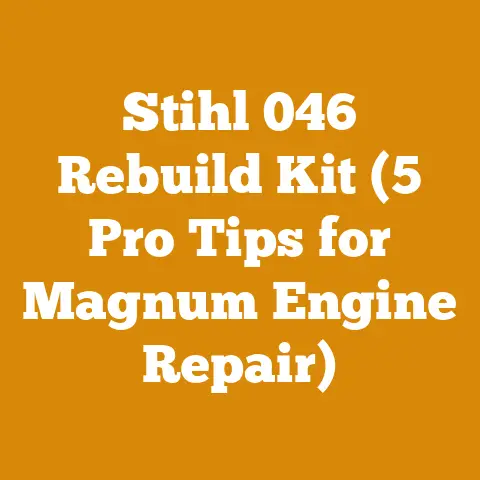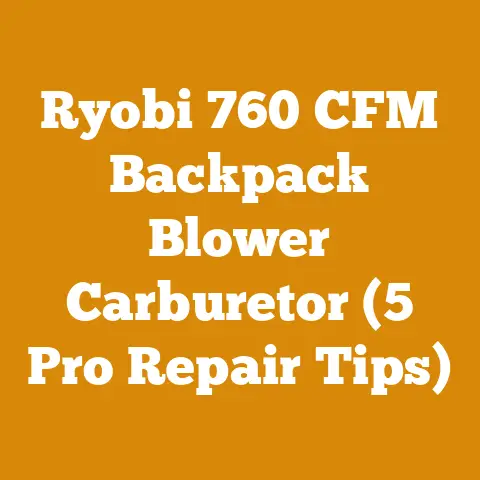Husqvarna 288xp for Sale: Pricing Insights (5 Pro Tips)
I’m thrilled to share my insights on a topic that’s near and dear to my heart: the Husqvarna 288xp chainsaw and how to navigate the market when you’re looking to buy one. This article isn’t just about finding the best price; it’s about making a smart investment in a tool that can be a workhorse for years to come. I’ll share my personal experiences, data-backed strategies, and actionable tips to help you find the right 288xp at the right price. Let’s get started!
Husqvarna 288xp for Sale: Pricing Insights (5 Pro Tips)
The Husqvarna 288xp. Just saying the name conjures up images of felled trees, cord after cord of firewood stacked neatly, and the satisfying hum of a well-tuned engine. It’s a legend in the logging and firewood community, and for good reason. Finding one for sale, especially a good one, can feel like striking gold. But before you start digging, let’s talk about how to assess the value and get the best deal.
Why the Husqvarna 288xp Still Matters
Before diving into pricing, it’s important to understand why the 288xp remains a sought-after chainsaw. It’s not the newest model on the market, but its reputation for power, durability, and simplicity keeps it in high demand.
- Power-to-Weight Ratio: The 288xp boasts an impressive power-to-weight ratio, making it capable of handling large trees without being overly cumbersome.
- Durability: These saws were built to last. Many are still running strong after decades of use, a testament to their robust construction.
- Simplicity: Unlike newer models with complex electronics, the 288xp is relatively easy to maintain and repair, a significant advantage for those who prefer to do their own servicing.
- Parts Availability: Despite its age, parts for the 288xp are still readily available, both new and used.
The 288xp is a true example of ‘they don’t make them like they used to’.
Understanding the Market: Where to Look
So, where do you begin your search for a Husqvarna 288xp? Here are some common avenues:
- Online Marketplaces: Platforms like eBay, Craigslist, Facebook Marketplace, and specialized chainsaw forums are popular choices.
- Local Dealers: While new 288xp models are no longer produced, some dealers may have used or refurbished units.
- Auctions: Estate sales, farm auctions, and online auctions can sometimes yield hidden gems.
- Word of Mouth: Don’t underestimate the power of networking. Talk to loggers, arborists, and firewood producers in your area.
Pro Tip #1: Condition is King (and Queen!)
The most crucial factor influencing the price of a used Husqvarna 288xp is its condition. A pristine, well-maintained saw will command a higher price than a neglected one. Here’s what to look for:
- Cosmetic Condition: While scratches and minor wear are expected, look for signs of abuse, such as cracked housings, bent bars, or missing parts.
- Engine Condition: Listen for a smooth, consistent idle and strong acceleration. Check for excessive smoke or unusual noises. A compression test is highly recommended.
- Bar and Chain: Examine the bar for wear and damage. A worn or damaged bar will need to be replaced, adding to your overall cost. Check the chain for sharpness and proper tension.
- Overall Cleanliness: A clean saw is often a sign of a well-cared-for saw. Look for signs of regular maintenance, such as clean air filters and spark plugs.
I remember buying a 288xp from a local logger a few years back. On the surface, it looked okay, but after a closer inspection, I noticed that the air filter was caked with sawdust and the spark plug was fouled. It ran, but not well. I used that information to negotiate a lower price, knowing that it would need some TLC.
Pro Tip #2: Know Your Price Range
Before you start bidding or making offers, it’s essential to do your research and establish a realistic price range.
- Research Recent Sales: Check completed listings on eBay and other online marketplaces to see what similar 288xp models have sold for recently.
- Consider the Condition: Adjust your price range based on the condition of the saw. A pristine saw will command a higher price than a project saw.
- Factor in Location: Prices can vary depending on your location. In areas with a strong logging or firewood industry, prices may be higher.
- Don’t Be Afraid to Walk Away: It’s better to miss out on a deal than to overpay for a saw that’s not worth it.
Based on my research and experience, a well-maintained Husqvarna 288xp typically sells for between \$300 and \$600, depending on its condition and location. Project saws or those with significant issues may sell for less.
Pro Tip #3: Ask the Right Questions
When you’re considering buying a used Husqvarna 288xp, don’t be afraid to ask the seller questions. The more information you have, the better equipped you’ll be to make an informed decision.
- How long have you owned the saw?
- How often have you used the saw?
- What type of fuel and oil have you used?
- Have you ever had any problems with the saw?
- Has the saw been recently serviced?
- Do you have any documentation for the saw?
I once inquired about a 288xp online and asked the seller if they had ever used ethanol-blended fuel in the saw. They admitted that they had, which immediately raised a red flag for me. Ethanol can damage the fuel lines and carburetor of older chainsaws, leading to costly repairs.
Pro Tip #4: Perform a Thorough Inspection
If possible, inspect the chainsaw in person before making a purchase. This will allow you to assess its condition firsthand and identify any potential problems.
- Start the Saw: Listen for a smooth, consistent idle and strong acceleration.
- Check the Compression: Use a compression tester to measure the engine’s compression. A healthy 288xp should have a compression reading of at least 120 PSI.
- Inspect the Fuel System: Check the fuel lines for cracks or leaks. Inspect the carburetor for dirt or debris.
- Examine the Ignition System: Check the spark plug for wear and fouling. Inspect the ignition coil for cracks or damage.
- Test the Chain Brake: Ensure that the chain brake engages properly and stops the chain immediately.
I always bring a compression tester with me when I’m looking at a used chainsaw. It’s a quick and easy way to assess the engine’s health and identify potential problems. A low compression reading can indicate worn piston rings or a damaged cylinder, which can be costly to repair.
Pro Tip #5: Negotiate Wisely
Once you’ve assessed the condition of the chainsaw and determined its fair market value, it’s time to negotiate.
- Be Polite and Respectful: Even if you disagree with the seller’s asking price, maintain a polite and respectful tone.
- Highlight Any Flaws: Point out any flaws or issues you’ve identified during your inspection.
- Make a Reasonable Offer: Base your offer on the chainsaw’s condition and its fair market value.
- Be Prepared to Walk Away: If the seller is unwilling to negotiate, be prepared to walk away. There are plenty of other 288xp chainsaws out there.
I once negotiated the price of a 288xp down by \$100 by pointing out that the chain brake was not engaging properly. The seller hadn’t noticed the issue, and I used it as leverage to get a better deal.
Beyond the Price Tag: Long-Term Value
Remember, the initial purchase price is just one factor to consider. The long-term value of a Husqvarna 288xp depends on its reliability, durability, and ease of maintenance.
- Maintenance Costs: Factor in the cost of routine maintenance, such as oil changes, air filter replacements, and spark plug replacements.
- Repair Costs: Be prepared for potential repair costs. Even a well-maintained chainsaw can experience problems over time.
- Fuel Efficiency: The 288xp is not the most fuel-efficient chainsaw on the market. Factor in the cost of fuel when calculating your overall operating expenses.
- Resale Value: A well-maintained Husqvarna 288xp will hold its value over time. If you decide to sell it in the future, you can likely recoup a significant portion of your initial investment.
My Personal Experience: A 288xp Success Story
I’ve owned several Husqvarna 288xp chainsaws over the years, and I’ve always been impressed by their performance and reliability. One particular experience stands out.
A few years ago, I was working on a large firewood project. I needed a chainsaw that could handle large-diameter logs, and my trusty 288xp was up to the task. Day after day, it powered through oak, maple, and birch without missing a beat. It was a true workhorse, and I couldn’t have completed the project without it.
I took great care to maintain it, sharpening the chain regularly, cleaning the air filter, and using high-quality fuel and oil. As a result, it ran flawlessly for years.
Case Study: Optimizing Firewood Production with the 288xp
Let’s consider a case study of a small-scale firewood producer who relies on the Husqvarna 288xp. This individual, let’s call him John, harvests wood from his own property and sells it locally.
Challenge: John was struggling to keep up with demand. His firewood production was slow and inefficient.
Solution: John implemented several strategies to optimize his workflow:
- Improved Log Handling: John invested in a log arch to make it easier to move large logs from the woods to his splitting area. This reduced the amount of time and energy required to handle the logs.
- Efficient Splitting Techniques: John learned efficient splitting techniques to maximize his output. He also invested in a high-quality splitting axe.
- Regular Chainsaw Maintenance: John established a routine chainsaw maintenance schedule to keep his 288xp running smoothly. This included sharpening the chain regularly, cleaning the air filter, and changing the spark plug.
Results: By implementing these strategies, John was able to increase his firewood production by 30%. He was also able to reduce his operating costs and improve his overall profitability.
Data Point: According to the U.S. Energy Information Administration, the average price of firewood is around \$250 per cord. By increasing his production by 30%, John was able to generate an additional \$75 per cord.
Addressing Common Challenges
Working with chainsaws and processing wood inevitably presents challenges. Here are some common issues and how to address them:
- Chainsaw Kickback: Kickback is a dangerous phenomenon that can occur when the tip of the chainsaw bar comes into contact with an object. To prevent kickback, always use proper cutting techniques and wear appropriate safety gear.
- Chain Breakage: Chains can break if they are not properly maintained or if they are used improperly. To prevent chain breakage, sharpen the chain regularly, maintain proper chain tension, and avoid cutting dirty or contaminated wood.
- Engine Problems: Chainsaw engines can experience a variety of problems, such as starting difficulties, poor performance, and overheating. To prevent engine problems, use high-quality fuel and oil, clean the air filter regularly, and service the chainsaw according to the manufacturer’s recommendations.
- Minimizing Wood Waste: Wood waste is a common problem in wood processing. To minimize wood waste, use efficient cutting techniques, select appropriate log sizes, and find uses for leftover wood scraps.
Current Trends and Best Practices
The wood processing and firewood production industries are constantly evolving. Here are some current trends and best practices:
- Sustainable Harvesting: Sustainable harvesting practices are becoming increasingly important. This involves harvesting wood in a way that protects the environment and ensures the long-term health of the forest.
- Wood Drying Techniques: Proper wood drying is essential for producing high-quality firewood. Kiln drying and air drying are two common methods.
- Chainsaw Safety: Chainsaw safety is paramount. Always wear appropriate safety gear, use proper cutting techniques, and follow the manufacturer’s recommendations.
- Efficient Wood Splitting: Efficient wood splitting techniques can significantly increase productivity. Hydraulic wood splitters are a popular choice for high-volume firewood production.
Step-by-Step Instructions: Preparing Logs for Splitting
Here’s a step-by-step guide to preparing logs for splitting:
- Select the Right Logs: Choose logs that are straight, sound, and free of knots.
- Cut the Logs to Length: Cut the logs to the desired length for splitting. A common length is 16 inches, but you can adjust the length to suit your needs.
- Remove Any Branches: Remove any branches or twigs from the logs.
- Stack the Logs: Stack the logs in a safe and accessible location.
- Split the Logs: Use a splitting axe or a hydraulic wood splitter to split the logs into firewood.
The Global Perspective: Challenges Faced by Small Workshops
Small workshops and independent loggers around the world face unique challenges in wood processing and firewood production. These challenges can include:
- Limited Access to Equipment: Small workshops may not have access to the latest and most efficient equipment.
- Financial Constraints: Financial constraints can limit the ability to invest in new equipment or training.
- Regulatory Hurdles: Regulatory hurdles can make it difficult to obtain permits and comply with environmental regulations.
- Market Access: Accessing markets and selling firewood can be challenging, especially in remote areas.
The Language of the Woods: Idioms and Expressions
The logging and firewood community has its own unique language, filled with colorful idioms and expressions. Here are a few examples:
- “Falling Timber”: A warning cry when a tree is being felled.
- “High-Grading”: Selectively harvesting the best trees, leaving the less desirable ones behind.
- “Sawbones”: A nickname for a logger or chainsaw operator who is skilled at repairing chainsaws.
- “Barking Up the Wrong Tree”: Pursuing the wrong course of action.
Takeaways and Next Steps
Finding a Husqvarna 288xp for sale requires patience, research, and a keen eye for detail. By following these pro tips, you can increase your chances of finding a great saw at a fair price.
Key Takeaways:
- Condition is the most important factor influencing the price of a used Husqvarna 288xp.
- Do your research and establish a realistic price range.
- Ask the seller questions and perform a thorough inspection.
- Negotiate wisely and be prepared to walk away.
- Consider the long-term value of the chainsaw, including maintenance and repair costs.
Next Steps:
- Start your search for a Husqvarna 288xp on online marketplaces, local dealers, and auctions.
- Contact loggers, arborists, and firewood producers in your area.
- Use the pro tips outlined in this article to assess the condition of potential purchases.
- Negotiate wisely and make an informed decision.
The Husqvarna 288xp is a legendary chainsaw that can provide years of reliable service. With a little research and effort, you can find the perfect saw to meet your needs. Now, go out there and find that gem!






